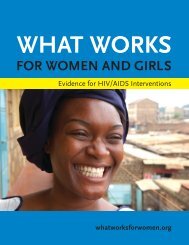Global Tuberculosis Report -- 2012.pdf
Global Tuberculosis Report -- 2012.pdf
Global Tuberculosis Report -- 2012.pdf
Create successful ePaper yourself
Turn your PDF publications into a flip-book with our unique Google optimized e-Paper software.
FIGURE 5.5Trends in domestic and donor funding for TB care and control, 2006–2013, by country group aBRICS3000400Other HBCsLow--income countries200Domestic sourcesincluding GHS,5−95th percentiles aForeign sourcesincluding <strong>Global</strong> Fund,5−95th percentiles a<strong>Global</strong> Fund only,best estimateUS$ millions (constant 2012 US$)200010003002001001501005002006 2008 2010 201202006 2008 2010 201202006 2008 2010 2012aIn probabilistic sensitivity analysis, the percentage of GHS costs that is domestically funded in low-income countries is assumed to follow a uniform distribution, rangingfrom the percentage of NTP funding from domestic sources up to 100%.grants from the <strong>Global</strong> Fund (Table 5.2). Funding reportedby NTPs from other donor sources amounts to onlyUS$ 54 million in 2013, although bilateral and multilateralfunds are not always channelled through NTPs. Forexample, donors may provide funding directly to nongovernmentalorganizations and to technical agencies. Recentdata on technical assistance compiled by TB-TEAM (TBTechnical Assistance Mechanism) are provided in Box 5.2.International donor funding for TB care and controlhas increased from US$ 0.2 billion in 2006 to almostUS$ 0.5 billion in 2013, but still falls short of funding formalaria (US$ 2.0 billion in 2010) 1 and HIV (US$ 6.9 billionin 2010). 2<strong>Global</strong> statistics on sources of funding conceal importantvariations in the extent to which countries rely ondomestic and donor financing (Figure 5.5, Figure 5.6, Table5.2). Differences among BRICS, the other 17 HBCs andthe group of low-income countries are especially striking(Figure 5.5). In BRICS, domestic funding has consistentlyaccounted for most of the funding for TB care and control(for example, >95% in 2012 and 2013), although India isan outlier at 71% in 2013. In the other 17 HBCs (listed inTable 5.2), the share of total funding from donor sourceswas in the range 28–41% between 2006 and 2013. Thegroup of low-income countries (24 African countriesas well as Afghanistan, Bangladesh, Cambodia, Haiti,Myanmar, Nepal and Somalia) are most reliant on donorfunding: for example, in 2012, 59% of total funding wasfrom donor sources. In 2013, 70% of available fundingwill be from donor sources in five HBCs: Afghanistan,Bangladesh, the Democratic Republic of the Congo, Ethiopiaand Myanmar (Table 5.2).Throughout the period 2006–2011, donor fundingexceeded domestic funding in low-income countries,and in 2010 and 2011 financing from the <strong>Global</strong> Fundalone exceeded domestic contributions. The data reportedin 2012 suggest that this pattern will persist in 2012 and2013. The <strong>Global</strong> Fund has a crucial role in sustaining andensuring further progress in TB care and control.Of particular concern is the expectation that donorfunding will be lower in 2013 compared with 2012 inthe 17 HBCs outside BRICS and low-income countries(current data suggest decreases of up to 33% and 18%,respectively). Donor funding is essential to safeguardrecent gains in TB control in the 17 HBCs outside BRICSand low-income countries.5.4 Funding for TB care and controlcompared with total governmentexpenditures on health careIn general, spending on TB control as a proportion ofpublic sector health expenditures 3 is relatively low (Figure5.7). In most countries, TB control accounts for lessthan 3% of public health expenditures. Countries withhigher levels of spending on TB relative to total governmentexpenditures on health are mostly in Africa, easternEurope (for example, Ukraine) or central Asia. Partof the explanation for countries in eastern Europe andcentral Asia is comparatively high levels of MDR-TB (seeChapter 4), which is more expensive to treat. Other reasonsinclude continued use of models of care for all formsof TB that rely extensively on inpatient care. For example,in Kazakhstan, 84% of smear-negative cases 4 and 96%1World malaria report 2011. Geneva, World Health Organization,2011.2Financing the response to AIDS in low- and middle-income countries:international assistance from donor governments in 2010. UNAIDSand the Kaiser Family Foundation, 2010 (also available at www.unaids.org).3Source: World Health Organization National Health Accountdatabase (www.who.int/nha/en) accessed via http://data.worldbank.org/indicator/SH.XPD.PUBL.ZS in July 2012.4For case definitions, see Chapter 3.GLOBAL TUBERCULOSIS REPORT 2012 57
















